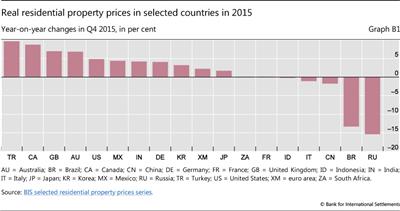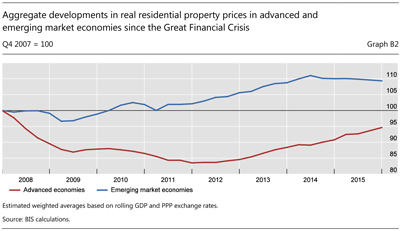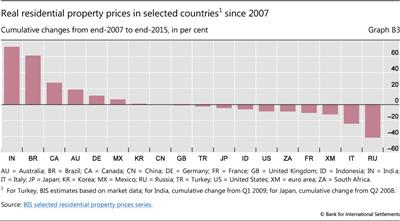Residential property price developments
Residential property prices increased significantly in advanced economies during 2015 (Graph B1). They rose by 4% on average in the fourth quarter of 2015 on a year-on-year basis in real terms (ie deflated by the CPI), and their growth was particularly strong in Australia, Canada, the United Kingdom and the United States. Prices grew more moderately in Japan and also in the euro area, mainly driven by developments in Germany and Spain.
Most of the emerging market economies (EMEs) also experienced strong increases, eg Korea, India, Mexico and especially Turkey. However, prices fell markedly in some of the larger countries, in particular by around 15% in both Brazil and Russia. The result was an overall decline of 1% on average for all emerging regions (Graph B1).
Developments since 2007
Real residential property prices at the end of 2015 were still moderately (by 5%) below their end-2007 levels for the group of advanced economies, despite the rebound observed in the past few years (Graph B2). This gap stood at 8% in the United States, despite the rally observed since mid-2011, but has narrowed more in Japan and the United Kingdom (Graph B3). It is significantly larger (-12%) in the euro area. Real property prices remain sharply lower in Spain than they were in 2007, despite having bottomed out in 2013, and are also below 2007 levels in France and Italy. However, prices are well above their pre-crisis levels in Germany. They have increased markedly in the economies which were less affected by the Great Financial Crisis, especially Australia (by almost 20%) and Canada (by almost 30%).
In contrast, residential property prices have on average been trending upwards for EMEs since the crisis. They exceed their 2007 levels by 9% in real terms. However, there have been significant disparities across countries. Prices have increased by around two thirds in Brazil (despite a significant downward correction in the last two years) and India, but significantly less in Mexico. They are roughly at their 2007 levels in China and Korea, and have fallen moderately in Indonesia and South Africa. Prices have dropped sharply since the crisis in several central and eastern European countries, in particular by more than 40% in Russia.
 A note focusing on the most recent developments is published in February, August and November. Q1 2016 data for some countries are already available in the BIS data sets, but Q4 2015 data are not yet available for Chile.
A note focusing on the most recent developments is published in February, August and November. Q1 2016 data for some countries are already available in the BIS data sets, but Q4 2015 data are not yet available for Chile.  Price developments since early 2008 for Japan and early 2009 for India. For China, BIS calculation based on the average of the prices reported for the 70 largest cities.
Price developments since early 2008 for Japan and early 2009 for India. For China, BIS calculation based on the average of the prices reported for the 70 largest cities.
References:
Scatigna, M and R Szemere (2015): "BIS collection and publication of residential property prices", Irving Fisher Committee Bulletin, no 39, April.
Scatigna, M, R Szemere and K Tsatsaronis (2014): "Residential property price statistics across the globe", BIS Quarterly Review, September, pp 61-76.
Shim, I and K Kuttner (2013): "Can non-interest rate policies stabilise housing markets? Evidence from a panel of 57 economies", BIS Working Papers, no 433, November.
Tissot, B (2014): "Monitoring house prices from a financial stability perspective - the BIS experience", International Statistical Institute Regional Statistics Conference, November.




